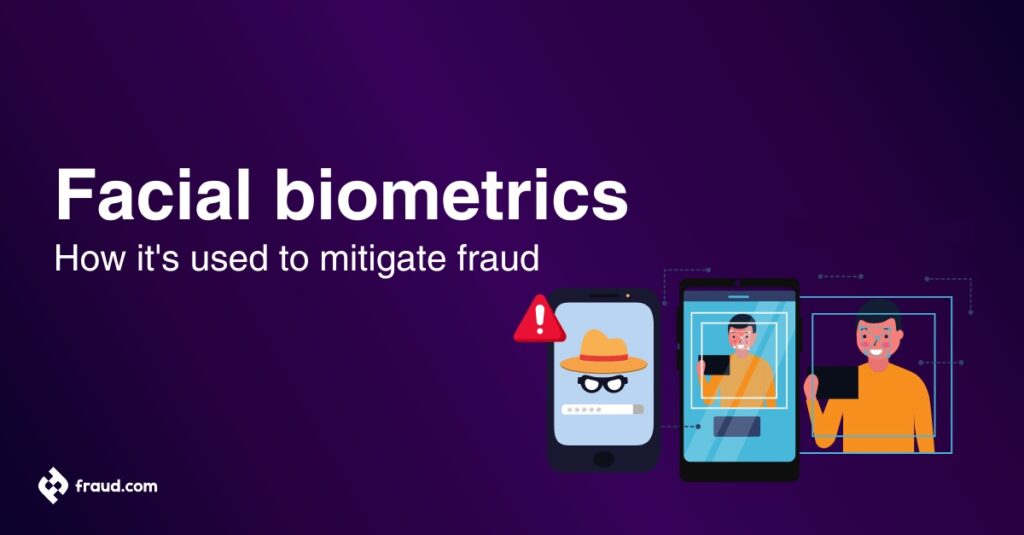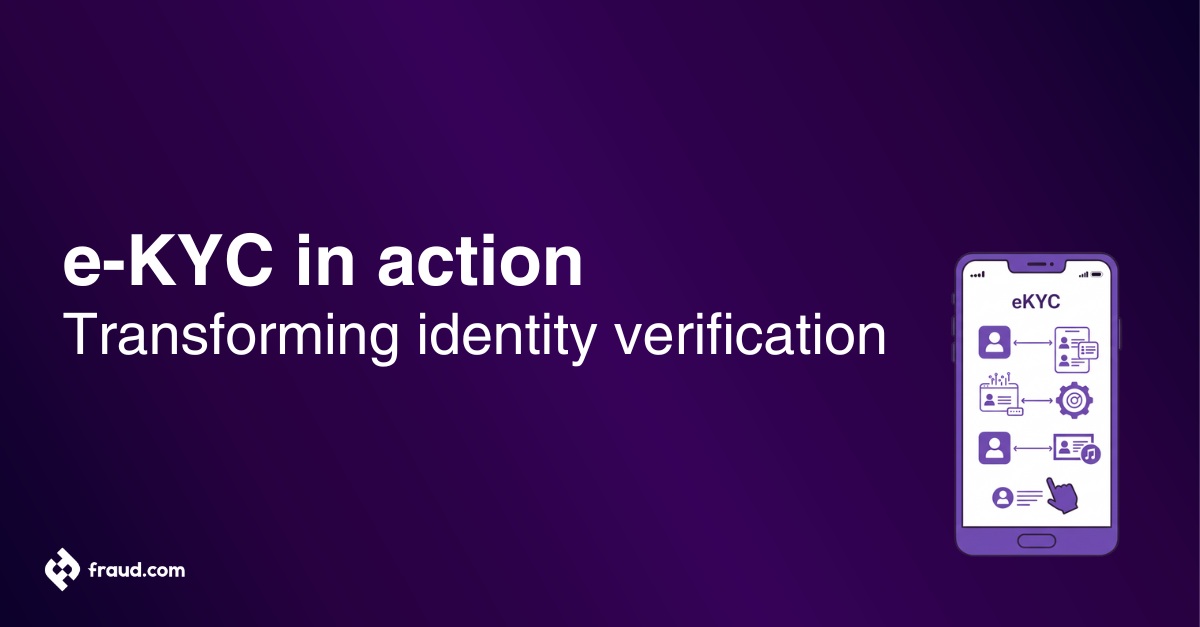Fraud is an ever-changing and increasing threat to both, individuals and organisations, as a result a wide array of biometric verification and authentication methods have developed over time, and ensuring robust identity verification measures has become vital. Facial biometrics technology has emerged as a powerful verification and authentication tool for mitigating fraud and enhancing security across various sectors. This article sheds light on the significance of facial biometrics in identity verification and explores the efficacy of this cutting-edge technology to help mitigate fraud.
Table of Contents
ToggleWhat is facial biometrics
Facial biometrics refers to the use of unique facial features to identify individuals. It involves capturing and analyzing facial characteristics such as the distance between eyes, the shape of the nose, and the contours of the face. This information is then used to verify or authenticate a person’s identity. Facial recognition technology is frequently used for security measures, entry management, and identity verification across different sectors.
This method employs advanced biometric facial recognition software and intricate algorithms to discern and extract pivotal facial traits, encompassing everything from facial expressions to subtle contours and patterns. By harnessing the power of artificial intelligence and cutting-edge biometric technology, facial biometrics facilitates instantaneous biometric identification of individuals based on their facial composition, ushering in a realm of real-time authentication and verification.
How does facial biometrics work?
Facial biometrics has emerged as a sophisticated technology for identifying individuals by analyzing their facial features. It operates through a series of systematic steps, beginning with the capture of facial images or videos through cameras or similar devices. These captured images then undergo a process of pre-processing to ensure optimal quality and alignment.
Following this, facial recognition operates using algorithms that pull out unique characteristics from the face, making it easier to compare with templates stored in a database. This comparison leads to the identification of individuals based on the best match found. This process enables real-time identification, offering instant and accurate results across diverse applications, from access control to mobile authentication. Let’s look into each step in detail:
- Capture: Facial biometrics systems commence by capturing images or videos of an individual’s face using mobile phone cameras or other devices. This initial step serves as the foundation for subsequent analysis and identification.
- Pre-processing: Following capture, the captured facial images undergo pre-processing. This stage involves enhancing the quality of the images, aligning them correctly, and normalizing them to ensure consistency and accuracy in subsequent analysis.
- Feature extraction: Facial recognition algorithms then extract essential facial features from the pre-processed images. These features include but are not limited to the distance between eyes, the shape of the nose, and the contours of the face, which collectively form a unique facial signature.
- Feature comparison: The extracted facial features are compared with stored facial templates within a facial recognition database. This comparison aims to identify similarities and differences, crucial for accurate authentication. If it’s the first time capturing the individual’s face then it would be for verification purposes and consequently store their facial biometric data.
- Matching and identification: If there’s existing verified facial biometric data then upon comparison, the system matches the extracted facial features with the stored templates, seeking the best possible match. This matching process leads to the identification of the individual associated with the matched template.
One of the significant advantages of facial biometrics is its ability to perform in real time. This capability enables instant and precise identification in various scenarios, including access control systems, mobile authentication, and security checkpoints.
Facial biometrics offers a robust solution for identifying individuals by leveraging the unique characteristics of their faces. From the initial capture of facial images to the real-time identification process, each step plays a crucial role in ensuring accuracy and reliability. As face recognition technology continues to advance, facial biometrics is expected to play an increasingly integral role in various sectors, contributing to enhanced identity verification and authentication, security, convenience, and efficiency.
Facial biometric recognition methods
Facial biometric recognition methods encompass a range of techniques designed to identify people based on unique characteristics of their faces. These methods leverage different technologies and approaches to achieve varying levels of accuracy and applicability. From 2D and 3D facial recognition to thermal and infrared techniques, each method offers distinct advantages suited to particular environments and scenarios. Let’s explore them:
- 2D facial recognition: 2D facial recognition analyzes two-dimensional images of faces, making it widely accessible for various applications. It relies on features visible in flat images, such as the arrangement of facial features and their proportions, for identification.
- 3D facial recognition: In contrast to 2D methods, 3D facial recognition captures and analyzes depth information of the face. This approach offers higher accuracy and robustness against spoofing attempts, as it considers the three-dimensional structure of the face, including contours and surface details.
- Thermal facial fecognition: Thermal facial recognition uses thermal imaging technology to detect and analyze heat patterns on a person’s face. By measuring differences in temperature, this technique can identify individuals even in low-light conditions or when traditional visual features are obscured.
- Infrared facial recognition: Infrared facial recognition employs infrared cameras to capture facial images, enabling accurate identification regardless of lighting conditions. This method is particularly useful in environments with poor lighting or where visible light imaging may not be feasible, such as outdoor settings at night.
- Motion-based facial recognition: This method involves analyzing the unique way individuals move their faces or expressions. It can be used in combination with other biometric methods or as a standalone technique, providing an additional layer of security and accuracy.
- Multi-spectral facial recognition: Multi-spectral facial recognition combines data from multiple imaging modalities, such as visible, infrared, and thermal spectra, to enhance accuracy and reliability. By incorporating different types of information, this method can overcome challenges posed by varying environmental conditions and improve overall performance.
Facial biometric recognition methods continue to evolve and diversify, offering a range of options suited to different operational requirements and environmental constraints. From traditional 2D approaches to advanced multi-spectral techniques, each method contributes to the broader goal of accurate and reliable facial identification. As technology advances and new innovations emerge, facial biometrics will likely play an increasingly vital role in various sectors, including security, access control, and identity verification.
Role of facial biometrics in identity verification
Facial biometrics has become increasingly integral to identity verification processes, offering numerous advantages over traditional methods like passwords and PINs, allowing smooth and efficient passwordless authentication. Leveraging the unique and relatively unchanging nature of facial features, this technology provides a robust means of authenticating individuals in various contexts. Let’s explore the role of facial biometrics in identity verification processes:
- Unique and unchangeable: Facial biometrics relies on the inherent uniqueness of facial features, which are distinct to each individual and tend to remain consistent over time. This characteristic makes facial recognition a reliable method for verifying identity, as it is less susceptible to manipulation or alteration compared to other forms of identification.
- User-friendly and non-invasive: One of the key benefits of facial biometrics is its non-invasive nature. Unlike traditional methods that may require physical tokens or inputs, facial recognition simply involves capturing and analyzing facial images or videos. This approach is user-friendly, convenient, and eliminates the need for individuals to remember passwords or carry physical tokens.
- Real-time authentication: Facial biometrics enables real-time authentication, allowing for instant verification of identity. Whether it’s unlocking a device, accessing secure locations, or conducting transactions, the speed and efficiency of facial recognition contribute to a seamless user experience and streamlined operations.
- Resistance to fraud: Facial biometrics systems are designed to resist various forms of fraud, including identity spoofing and impersonation. Advanced algorithms and techniques are employed to detect anomalies and ensure that the facial features presented for Knowledge Based Authentication (KBA) correspond to legitimate individuals. This enhances security and reduces the risk of unauthorized access or fraudulent activity.
In conclusion, facial biometrics serves as a cornerstone in modern identity verification processes, offering unparalleled advantages in terms of accuracy, convenience, and security. Its ability to leverage unique facial features, provide real-time authentication, and resist fraudulent attempts makes it a highly effective tool in diverse applications, from access control and financial transactions to border security and law enforcement. As technology continues to advance, facial biometrics is expected to play an increasingly pivotal role in safeguarding identities and enhancing overall security measures.
Mitigating fraud through facial biometrics
Facial biometrics technology stands as a formidable ally in the battle against fraud. Its efficacy in fraud preventionis thoroughly recorded, thanks to the impressive advancements in precision and dependability made by facial recognition systems.. These advancements, fueled by the continuous evolution of facial recognition algorithms and artificial intelligence, have fortified the capabilities of facial biometrics to unprecedented levels.
This technology serves as a cornerstone for law enforcement agencies, financial institutions and diverse industries, providing a potent arsenal for identifying suspects, monitoring individuals, and swiftly detecting fraudulent activities. Its versatile applications extend across various sectors, including finance, retail, and transportation, where it serves as a vigilant guardian against fraudulent transactions, unauthorized access, and identity theft.
By harnessing the power of facial biometrics, organizations can fortify their defenses against the ever-present threat of fraud, bolstering security measures and safeguarding users and valuable assets. With its proven track record and ongoing advancements, facial biometrics remains at the forefront of fraud mitigation efforts, offering a potent combination of precision, reliability, and versatility in combating fraudulent activities.
Challenges of facial biometrics
Implementing facial biometric systems for identity verification may pose several challenges, ranging from technical limitations to privacy concerns. Addressing these challenges is essential to ensure the successful deployment and operation of facial biometric technology in various applications.
Common challenges:
- Environmental factors: Environmental factors such as varying lighting conditions, extreme temperatures, and background noise can affect the performance of facial biometric systems. These factors may lead to inaccurate facial recognition results and hinder the overall reliability of the system.
- Facial diversity: Human faces exhibit a wide range of diversity in terms of ethnicity, age, gender, and facial features. Recognizing and accurately identifying individuals across diverse demographic groups poses a significant challenge for facial biometric systems, which must account for this variability to avoid biases and inaccuracies.
- Performance degradation: Over time, facial biometric systems may experience performance degradation due to factors such as aging hardware, software bugs, or changes in environmental conditions. Maintaining consistent performance and accuracy requires ongoing monitoring, maintenance, and periodic system upgrades.
- Privacy concerns: Collecting and storing facial biometric data raises privacy concerns, as it involves capturing sensitive information about individuals’ unique physical characteristics. Safeguarding this data from unauthorized access, misuse, or breaches is critical to maintaining trust and compliance with privacy regulations.
- Security vulnerabilities: Like any biometric system, facial biometrics are susceptible to security vulnerabilities such as spoofing attacks, where individuals attempt to deceive the system by presenting fake or altered facial images. Mitigating these vulnerabilities requires robust security measures and anti-spoofing techniques.
- User acceptance: Achieving user acceptance and trust in facial biometric systems can be challenging, especially in environments where individuals may be apprehensive about biometric data collection or concerned about privacy implications. Educating users about the benefits and security measures of facial biometrics is essential to fostering acceptance and adoption.
Solutions for these challenges:
- Environmental adaptation: Develop facial biometric algorithms that can adapt to diverse environmental conditions, such as variations in lighting and background noise. Incorporate advanced image processing techniques and machine learning algorithms to enhance system robustness and performance under challenging environments. Moreoever, Facial biometrics technology often benefits from research and standards set by organizations like the National Institute of Standards and Technology (NIST), ensuring advancements and reliability in identification systems.
- Diverse dataset training: Train facial recognition models on diverse datasets that represent a wide range of demographic groups, ensuring that the system is capable of accurately recognizing individuals across different ethnicities, ages, and genders. Implement bias detection and mitigation techniques to minimize biases in facial recognition algorithms.
- Continuous monitoring and maintenance: Implement proactive monitoring and maintenance procedures to detect and address performance degradation in facial biometric systems. Conduct regular system audits, hardware inspections, and software updates to ensure optimal performance and reliability over time.
- Privacy-enhancing measures: Implement privacy-enhancing measures such as data encryption, anonymization techniques, and strict access controls to protect facial biometric data from unauthorized access or misuse. Adhere to privacy regulations such as GDPR and CCPA to ensure compliance and transparency in data handling practices.
- Anti-spoofing technologies: Integrate anti-spoofing technologies such as biometric liveness detection and texture analysis into facial biometric systems to detect and prevent spoofing attacks. Incorporate multi-factor authentication methods to enhance security and mitigate the risk of unauthorized access.
- User education and engagement: Educate users about the benefits, security measures, and privacy protections of facial biometric systems to promote acceptance and trust. Provide clear and transparent information about how facial biometrics are used, stored, and protected to address user concerns and build confidence in the technology.
By implementing these counteract solutions, organizations can effectively address the challenges associated with facial biometrics and maximize the effectiveness, reliability, and security of facial biometric systems for identity verification.
Applications of facial biometrics
Facial biometrics technology offers a wide range of applications, revolutionizing various industries with its versatility and effectiveness. Below are some detailed examples of how facial biometrics is adopted in different sectors:
- Access control: Facial biometrics is increasingly deployed in access control systems to enhance security and streamline entry processes. In corporate environments, employees can gain access to secure areas by simply presenting their faces to facial recognition scanners, eliminating the need for physical access cards or keys. Similarly, in residential buildings or public facilities, facial biometrics can be integrated into entry gates or turnstiles to grant authorized individuals entry based on facial recognition.
- Law enforcement: Law enforcement agencies leverage facial biometrics to aid in criminal investigations, identify suspects, and enhance public safety. Facial recognition technology enables authorities to match faces captured in surveillance footage or images against criminal databases, helping to identify individuals involved in crimes or locate missing persons. Additionally, facial biometrics can assist in monitoring crowded public spaces, identifying potential threats, and preventing criminal activities.
- Border security: Facial biometrics plays a crucial role in border security and immigration control by verifying the identities of travelers at ports of entry. Border control agencies use face detection or face recognition systems to compare travelers’ faces against watchlists or biometric databases, enabling rapid and accurate identity verification. This technology enhances border security by detecting fraudulent travel documents, identifying individuals with criminal backgrounds, and preventing unauthorized entry into the country.
- Retail analytics: Retailers harness facial biometrics to gather valuable insights into customer behavior, preferences, and demographics. By deploying facial recognition cameras in stores or shopping malls, retailers can analyze foot traffic patterns, track customer movements, and measure the effectiveness of marketing campaigns. Facial biometrics enables retailers to personalize shopping experiences, offer targeted promotions, and optimize store layouts based on customer demographics and preferences.
- Personalized marketing: Facial biometrics enables personalized marketing strategies by allowing businesses to tailor advertisements and promotions to individual customers based on their facial characteristics and preferences. Through facial recognition technology, retailers and advertisers can deliver targeted content, recommendations, and offers to customers in real time, enhancing engagement and driving sales. Personalized marketing campaigns leverage facial biometrics to create customized experiences that resonate with customers and drive brand loyalty through various means such as the use of social media.
In summary, facial biometrics transcends traditional identity verification to offer a multiple applications across various industries. From enhancing security and law enforcement efforts to optimizing retail operations and personalizing marketing initiatives, facial biometrics technology continues to revolutionize the way businesses and organizations operate, providing unprecedented levels of efficiency, security, and customer engagement.
Future trends in facial biometrics
As technology continues to evolve at a rapid pace, the field of facial biometrics is set for exceptional progress and changes. Here, we delve into the anticipated trends and breakthroughs that will shape the future of facial biometrics technology:
- Adoption of deep learning techniques: The future of facial biometrics will witness a significant surge in the adoption of deep learning techniques. Deep learning algorithms, fueled by vast datasets and computational power, will revolutionize facial recognition capabilities, enabling more accurate and robust identification of individuals. By leveraging deep neural networks, facial biometrics systems will achieve unprecedented levels of performance, surpassing traditional methods and enhancing security across various applications.
- Rise of edge computing for real-time processing: With the proliferation of Internet of Things (IoT) devices and the growing demand for real-time processing, edge computing will emerge as a key trend in facial biometrics technology. Edge computing architecture, which involves processing data locally on devices at the network edge, will enable faster and more efficient facial recognition tasks. By performing facial biometrics processing closer to the source of data capture, edge computing will reduce latency, enhance privacy, and enable seamless integration with IoT devices and surveillance systems.
- Emergence of new biometric modalities: In addition to traditional facial recognition methods, the future will witness the emergence of new biometric modalities that complement facial biometrics technology. Multimodal biometric systems, combining facial recognition with other biometric identifiers such as voice, iris, or gait, will offer enhanced security and accuracy in identity verification. By fusing multiple biometric modalities, these systems will mitigate the limitations of individual biometric traits and provide more reliable authentication solutions for diverse applications.
- Advancements in privacy-preserving techniques: As concerns over data privacy and security intensify, the future of facial biometrics will prioritize the development of privacy-preserving techniques. Innovations such as homomorphic encryption, differential privacy, and federated learning will enable facial biometrics systems to perform authentication tasks while preserving the privacy of individuals’ biometric data. By implementing robust privacy-enhancing measures, facial biometrics technology will uphold user privacy rights and foster trust among users and regulators.
- Integration with Augmented Reality (AR) and Virtual Reality (VR): The convergence of facial biometrics with augmented reality (AR) and virtual reality (VR) technologies will unlock new possibilities for immersive user experiences and interactive applications. Facial recognition capabilities will be seamlessly integrated into AR/VR environments, enabling personalized avatars, virtual identity authentication, and enhanced social interactions. This integration will blur the boundaries between physical and digital realms, ushering in a new era of immersive computing powered by facial biometrics technology.
In conclusion, the future of facial biometrics holds immense promise, driven by advancements in deep learning, edge computing, multimodal biometrics, privacy-preserving techniques, and AR/VR integration. These trends will not only revolutionize the way we authenticate identities and secure sensitive information but also pave the way for innovative applications across industries, from finance and healthcare to entertainment and beyond. As facial biometrics technology continues to evolve, it will undoubtedly shape the future of digital identity verification and redefine the way we interact with technology in our daily lives.
Facial biometrics by Udentify
Udentify stands as a comprehensive identity proofing and authentication solution, distinguished by its advanced facial biometrics capabilities. Here’s a detailed look at how Udentify adopts facial biometrics to redefine identity verification:
- Real identity verification via NFC/OCR & AI: Udentify surpasses traditional methods by integrating NFC for identification, OCR, and AI to authenticate individuals with multiple layers of verification, ensuring the authenticity and integrity of the process.
- Spoof-proof government-issued ID document: Udentify meticulously verifies the authenticity of government-issued ID documents, effectively thwarting forgery or manipulation attempts.
- Validating data in ID document chip: Through sophisticated cryptography, Udentify validates the data stored in ID document chips, guaranteeing its authenticity and integrity.
- Advanced AI and liveness detection: Leveraging advanced AI and liveness detection techniques, Udentify confirms that individuals presenting IDs are alive and accurately match the information in the document.
- Biometric authentication: Udentify leverages facial biometrics, among other methods, to ensure that only rightful owners can authenticate themselves, thereby deterring fraudsters effectively.
- Passive liveness detection: Udentify incorporates passive liveness detection to bolster security against spoofing attacks, achieving certification at Level-2 for ISO 30107-3 iBeta PAD testing.
- Strong Customer Authentication (SCA): Udentify automates Strong Customer Authentication (SCA), providing seamless verification through facial biometrics or voice recognition, striking a balance between security and user experience.
- KYC & AML Compliance: Udentify simplifies Know Your Customer (KYC) and Customer Due Diligence (CDD) processes through efficient identity verification via ID document scanning and AI facial recognition with certified liveness detection.
- User onboarding: With AI-powered facial verification and passive liveness detection, Udentify enables swift and frictionless user onboarding while upholding stringent security standards.
- Age verification: Leveraging NFC and OCR capabilities, Udentify enables quick and precise age verification, ensuring compliance with age-restricted commerce regulations.
- Passwordless authentication: Udentify offers passwordless authentication and Multi-Factor Authentication (MFA) through facial and voice biometric recognition, enhancing security and usability across various devices.
Udentify’s technology stack encompasses a wide array of ID documents, languages, and security features, ensuring compatibility and compliance with international standards. Organizations can rely on Udentify’s cutting-edge facial biometrics solution to combat fraud, enhance security, and streamline user experiences with unmatched efficiency and reliability.









